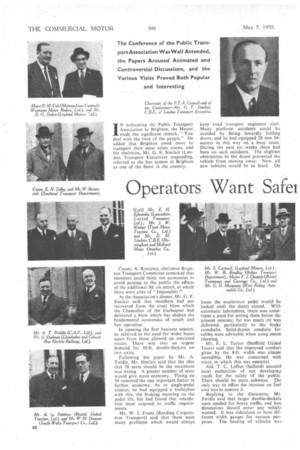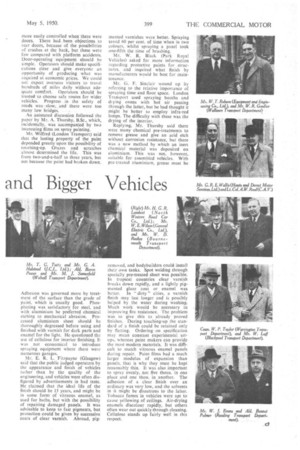Operators Want Safei and Bigger Vehicles
Page 42

Page 43

If you've noticed an error in this article please click here to report it so we can fix it.
IN welcoming the Public Transport Association to Brighton, the Mayor made the significant remark, "You deal_ with the lives of the people." He added that Brighton owed more to transport than most other towns. and the chairman, Mr. G. F. Sinclair (London Transport Executive) responding, referred to the bus system at Brighton as one of the finest in the country.
Counc. A. Rostance, chairman,Brighton Transport Committee remarked that members could think out economies to avoid passing to the public the effects of the additional 9d. on petrol, at which there were cries of "Impossible !"
At the Association's dinner, Mr. G. F. Sinclair said that members had not recovered from the cruel blow which the Chancellor of the Exchequer had delivered a blow which has shaken the fundamental economics of coach and bus operation.
In opening the first business session, he referred to the need for wider buses apart from those allowed on restricted routes. There was also an urgent demand for 30-ft. double-deckers on two axles.
Following the paper by Mr. A. Twidle, Mr. Sinclair said that the idea that 56 seats should be the maximum was wrong. A greater number of seats would give more economy. Fixing on 56 removed the one important factor in further economy. As to single-pedal control, he had equipped a trolleybus with this, •the braking occuring on the pedal lift, but had found that retardation must respond to traffic requirements.
Mr. W. J. Evans (Reading Corporation Transport) said that there were many problems which would always keep road transport engineers alert. Many platform accidents could be avoided •by fitting inwardly folding doors, and he had equipped 20 new 56seaters in this way on a busy route. During the past six weeks there had been no such accidents. The slightest obstruction to the doors prevented the vehicle from moving away. Now, all new vehicles would be so fitted. On buses the accelerator pedal would be locked until the doors closed. With automatic lubricalors, there was sometimes a need for setting them below The present minima; far too much oil was delivered, particularly to the brake camshafts. Solid-drawn conduits for cables were advisable when using steam cleaning.
Mr. E. L. Taylor (Sheffield United Tours) said that the improved comfort given by the 8-ft. width was almost incredible. He was concerned with tours, in which this was essential.
Aid. T. C. Loftus (Salford) accused local authorities of not developing roads for the safety of the public. There should be more subways. The only way to offset the increase on fuel cost was to remove it.
Replying to •the discussion, Mr. Twidle said that larger double-deckers were needed for heavy traffic, and box dimensions should cover any vehicle wanted. It was ridiculous to have different width gauges for various purposes. The heating of vehicles was
more easily controlled when'there were doors. There had been objections to rear doors, because of the possibilities of crashes at the back, but these were few compared with platform accidents. Door-operating equipment should he simple. Operators should make-specifications clear and give, everyone an opportunity of producing what was required at economic prices. We could not expect overseas visitors to travel hundreds of miles daily without adequate comfort. Operators should be trusted to choose safe routes for wider vehicles. Progress in the safety of roads was, °slow,. and there were too many low bridges,
An animated discussion followed the paper by Mr. A. Thursby, B.Sc., which, incidentally, was accompanied by two interesting films on spray painting.
Mr. Wilfred (London Transport) said that the lasting property of the paint depended greatly upon the possibility of touching-up. Grazes and scratches almost determined the life. This was from two-and-a-half to three years, but not because the paint had broken down.
Adhesion was governed more by treatment of the surface than the grade of paint, which is usually good. phosphating was satisfactory for steel, and with aluminium he preferred chemical etching to mechanical abrasion, Processed aluminium sheet should be thoroughly degreased before using and finished,with varnish for dark parts and enamel for the light. He questioned the use of cellulose for interior finishing. It was not economical to introduce spraying equipment where there were numerous garages,
Mr. E. R. L. Fitzpayae (Glasgow) said that the public judged operators by the appearance and finish of vehicles rather than by the quality of the engineering, and vehicles were often disfigured by advertisements in bad taste. He claimed that the ideal life of the finish should be 15 years, and might be in some form' of vitreous enamel, as used for baths, but with the possibility of repairing damaged panels. It was advisable to keep to fast pigments, but protection could be given by successive coats of clear varnish. Abroad, pig
mented varnishes were better. Spraying saved 60 per cent. of time when in two colours, whilst spraying a panel took one-fifth the time of brushing.
Mr. W. R. Black (Park Royal Vehicles) asked for more information regarding protective paints for structures, and inquired what finish by manufacturers would be best for maintenance.
Mr. G. F. Sinclair wound up by referring to the relative importance of spraying time and floor space. London Transport used spraying booths and drying ovens with hot air passing through the latter, but he had thought it might be better to employ infra-red lamps. The difficulty with these was the drying of the interior.
Replying, Mr. Thursby said there were many chemical pre-treatments to remove grease and give an acid etch without corrosion resistance, but there was a new method by which an inert chemical material was deposited on aluminium. This was not, however, suitable for assembled vehicles. With pre-treated aluminium, grease must be removed, and bodybuilders could install their own tanks. Spot welding through specially pre-treated sheet was possible. In tropical countries clear varnish breaks down rapidly, and a lightly pigmented glaze coat or enamel was better. In " dirty " cities, a varnish finish may last longer and is possibly helped by the water during washing. Much work would be necessary in improving fire resistance. The problem Was to give this to already proved finishes. During touching-up the standard of a finish could be retained only by flatting. Ordering on specification may mean constant experimental, setups, whereas paint makers can provide the most modern materials. It was difficult to match vitreous enamel panels during repair. Paint films had a much larger modulus of expansion than panels, that is why they must be kept reasonably thin. It was also important to spray evenly, not five thous. in one place and one thou. in another. The adhesion of a clear finish over an ordinary was very low, and the solvents in it might be disastrous to the latter. Tobacco fumes in vehicles were apt to cause yellowing of ceilings. Air-drying enamels discolour rapidly, but others often wear out quickly through cleaning. Cellulose stands up fairly well in this respect.
























































































